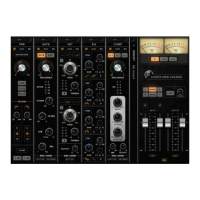Scheps Omni Channel / User Guide
Sidechain
Compressors, gates,
and de-essers use a gain attenuation device to alter the level of a given signal. This gain
attenuator can be a VCA, an FET, a tube, or an opto-resistor, depending on the design of the unit. This device is
controlled by a circuit that looks at the input signal and determines how much to attenuate the gain, based on
different settings (attack, release, ratio, and threshold). This circuit is known as the internal sidechain.
Example: Using an internal sidechain to reduce kick bleed in a snare track
A snare track often contains bleed from the kick. When gating the snare, this bleed can carry enough
energy
to open the snare’s gate. This can create a non-musical gate effect, since it should be the snare,
not the kick, controlling the gate. By applying a high-pass filter to the internal sidechain, the kick’s
energy is reduced to the point that it no longer opens the gate. The snare alone is now opening the
gate and there is no impact on the gate’s sound.
External Sidechain
Sometimes you need to control the dynamics of a channel based on the activity of another channel. This is known as
an external sidechain. This process is particularly useful when one channel is interfering with another and you want to
bring it forward or push it back without altering the dynamic characteristics of the entire track. E
ach of the Scheps Omni
Channel dynamics modules can accept an external sidechain. All modules in a plugin instance receive the same
external sidechain signal.
Example: Using an external sidechain to reduce bass gain to prevent it from clashing with the vocal
It’s common for a bass to interfere with a vocal track. You can, to an extent, tame this problem with level
control or EQ, but this undeniably compromises the performance. What you want is gain reduction on the
bass, based on the vocalist’s activity. Hence, an external sidechain.

